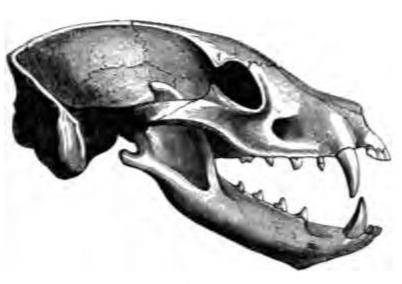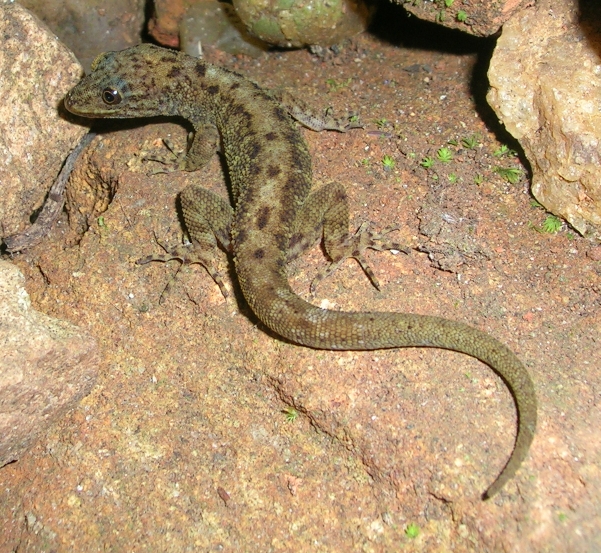|
Salim Ali's Dwarf Gecko
''Cnemaspis salimalii'', Salim Ali's dwarf gecko, is a species of diurnal, rock-dwelling, insectivorous gecko endemic to India. The species name In taxonomy, binomial nomenclature ("two-term naming system"), also called binary nomenclature, is a formal system of naming species of living things by giving each a name composed of two parts, both of which use Latin grammatical forms, altho ... honours Salim Ali. References Cnemaspis salimalii salimalii Reptiles of India Reptiles described in 2022 Taxa named by Ishan Agarwal Taxa named by Akshay Khandekar {{gekkonidae-stub ... [...More Info...] [...Related Items...] OR: [Wikipedia] [Google] [Baidu] |
Diurnality
Diurnality is a form of plant and ethology, animal behavior characterized by activity during daytime, with a period of sleeping or other inactivity at night. The common adjective used for daytime activity is "diurnal". The timing of activity by an animal depends on a variety of environmental factors such as the temperature, the ability to gather food by sight, the risk of predation, and the time of year. Diurnality is a cycle of activity within a 24-hour period; cyclic activities called circadian rhythms are endogenous cycles not dependent on external cues or environmental factors except for a zeitgeber. Animals active during twilight are crepuscular, those active during the night are nocturnal and animals active at sporadic times during both night and day are cathemerality, cathemeral. Plants that open their flowers during the daytime are described as diurnal, while those that bloom during nighttime are nocturnal. The timing of flower opening is often related to the time at whic ... [...More Info...] [...Related Items...] OR: [Wikipedia] [Google] [Baidu] |
Insectivorous
A robber fly eating a hoverfly An insectivore is a carnivorous animal or plant which eats insects. An alternative term is entomophage, which can also refer to the human practice of eating insects. The first vertebrate insectivores were amphibians. When they evolved 400 million years ago, the first amphibians were piscivores, with numerous sharp conical teeth, much like a modern crocodile. The same tooth arrangement is however also suited for eating animals with exoskeletons, thus the ability to eat insects can stem from piscivory. At one time, insectivorous mammals were scientifically classified in an order called Insectivora. This order is now abandoned, as not all insectivorous mammals are closely related. Most of the Insectivora taxa have been reclassified; those that have not yet been reclassified and found to be truly related to each other remain in the order Eulipotyphla. Although individually small, insects exist in enormous numbers. Insects make up ... [...More Info...] [...Related Items...] OR: [Wikipedia] [Google] [Baidu] |
Gecko
Geckos are small, mostly carnivorous lizards that have a wide distribution, found on every continent except Antarctica. Belonging to the infraorder Gekkota, geckos are found in warm climates. They range from . Geckos are unique among lizards for their vocalisations, which differ from species to species. Most geckos in the family Gekkonidae use chirping or clicking sounds in their social interactions. Tokay geckos (''Gekko gecko'') are known for their loud mating calls, and some other species are capable of making hissing noises when alarmed or threatened. They are the most species-rich group of lizards, with about 1,500 different species worldwide. All geckos, except species in the family Eublepharidae lack eyelids; instead, the outer surface of the eyeball has a transparent membrane, the brille. They have a fixed lens within each iris that enlarges in darkness to let in more light. Since they cannot blink, species without eyelids generally lick their own brilles whe ... [...More Info...] [...Related Items...] OR: [Wikipedia] [Google] [Baidu] |
India
India, officially the Republic of India, is a country in South Asia. It is the List of countries and dependencies by area, seventh-largest country by area; the List of countries by population (United Nations), most populous country since 2023; and, since its independence in 1947, the world's most populous democracy. Bounded by the Indian Ocean on the south, the Arabian Sea on the southwest, and the Bay of Bengal on the southeast, it shares land borders with Pakistan to the west; China, Nepal, and Bhutan to the north; and Bangladesh and Myanmar to the east. In the Indian Ocean, India is near Sri Lanka and the Maldives; its Andaman and Nicobar Islands share a maritime border with Thailand, Myanmar, and Indonesia. Modern humans arrived on the Indian subcontinent from Africa no later than 55,000 years ago., "Y-Chromosome and Mt-DNA data support the colonization of South Asia by modern humans originating in Africa. ... Coalescence dates for most non-European populations averag ... [...More Info...] [...Related Items...] OR: [Wikipedia] [Google] [Baidu] |
Species Name
In taxonomy, binomial nomenclature ("two-term naming system"), also called binary nomenclature, is a formal system of naming species of living things by giving each a name composed of two parts, both of which use Latin grammatical forms, although they can be based on words from other languages. Such a name is called a binomial name (often shortened to just "binomial"), a binomen, name, or a scientific name; more informally, it is also called a Latin name. In the International Code of Zoological Nomenclature (ICZN), the system is also called nomenclature, with an "n" before the "al" in "binominal", which is a typographic error, meaning "two-name naming system". The first part of the name – the '' generic name'' – identifies the genus to which the species belongs, whereas the second part – the specific name or specific epithet – distinguishes the species within the genus. For example, modern humans belong to the genus ''Homo'' and within this genus to the species ''Hom ... [...More Info...] [...Related Items...] OR: [Wikipedia] [Google] [Baidu] |
Salim Ali
Sálim Moizuddin Abdul Ali (12 November 1896 – 20 June 1987) was an Indian ornithologist and naturalist. Sometimes referred to as the "Birdman of India", Salim Ali was the first Indian to conduct systematic bird surveys across India and wrote several bird books that popularized ornithology in India. He became a key figure behind the Bombay Natural History Society after 1947 and used his personal influence to garner government support for the organisation, create the Bharatpur bird sanctuary (Keoladeo National Park) and prevent the destruction of what is now the Silent Valley National Park in Kerala. Along with Sidney Dillon Ripley he wrote the landmark ten volume '' Handbook of the Birds of India and Pakistan'', a second edition of which was completed after his death. He was awarded the Padma Bhushan in 1958 and the Padma Vibhushan in 1976, India's third and second highest civilian honours respectively. Several species of birds, Salim Ali's fruit bat, Salim Ali's dwarf gec ... [...More Info...] [...Related Items...] OR: [Wikipedia] [Google] [Baidu] |
Cnemaspis
''Cnemaspis'' is a genus of diurnal (day) geckos found in Asia. With over 100 species, it is one of the most diverse genera of geckos. Molecular phylogenies suggest that the two regional groupings may form distinct clades which are not each other's closest relatives. Description Species in this genus have slender, clawed digits which are cylindrical or depressed at the base (rarely dilated); the distal phalanges are compressed, forming an angle with the basal portion of the digits, the lower surface of which has a row of plates. Their bodies are more or less depressed, granular or tubercular above. Tail not compressed. Pupil circular; eyelid distinct all round the eye. Males with or without pre-anal or femoral pores. Species The Indian Subcontinent and Sri Lanka group *'' C. aaronbaueri'' Sayyed, Grismer, Campbell & Dileepkumar, 2019 *'' C. adii'' C. Srinivasulu, Kumar & B. Srinivasulu, 2015 – Adi's day gecko *'' C. agarwali'' Khandekar, 2019 – Agarwal's dwarf ge ... [...More Info...] [...Related Items...] OR: [Wikipedia] [Google] [Baidu] |
Reptiles Of India
Reptiles, as commonly defined, are a group of tetrapods with an ectothermic metabolism and amniotic development. Living traditional reptiles comprise four orders: Testudines, Crocodilia, Squamata, and Rhynchocephalia. About 12,000 living species of reptiles are listed in the Reptile Database. The study of the traditional reptile orders, customarily in combination with the study of modern amphibians, is called herpetology. Reptiles have been subject to several conflicting taxonomic definitions. In Linnaean taxonomy, reptiles are gathered together under the class Reptilia ( ), which corresponds to common usage. Modern cladistic taxonomy regards that group as paraphyletic, since genetic and paleontological evidence has determined that birds (class Aves), as members of Dinosauria, are more closely related to living crocodilians than to other reptiles, and are thus nested among reptiles from an evolutionary perspective. Many cladistic systems therefore redefine Reptilia as a ... [...More Info...] [...Related Items...] OR: [Wikipedia] [Google] [Baidu] |
Reptiles Described In 2022
Reptiles, as commonly defined, are a group of tetrapods with an ectothermic metabolism and amniotic development. Living traditional reptiles comprise four orders: Testudines, Crocodilia, Squamata, and Rhynchocephalia. About 12,000 living species of reptiles are listed in the Reptile Database. The study of the traditional reptile orders, customarily in combination with the study of modern amphibians, is called herpetology. Reptiles have been subject to several conflicting taxonomic definitions. In Linnaean taxonomy, reptiles are gathered together under the class Reptilia ( ), which corresponds to common usage. Modern cladistic taxonomy regards that group as paraphyletic, since genetic and paleontological evidence has determined that birds (class Aves), as members of Dinosauria, are more closely related to living crocodilians than to other reptiles, and are thus nested among reptiles from an evolutionary perspective. Many cladistic systems therefore redefine Reptilia as a clade ... [...More Info...] [...Related Items...] OR: [Wikipedia] [Google] [Baidu] |






